Last year Cavco introduced their first off-grid park model and I published a post on it. For 2010 Cavco is introducing a new park model called the Off-Grid Lodge and it was recently placed in the KOA campground in Herkimer, N.Y.
The 400-square foot unit has solar panels on its roof, which are capable of producing 2 kilowatts of power. The unit also has a prototype backup propane generator, bamboo flooring, LED lighting, recycled axels and tires, recycled lumber composite decking, rinnai on-demand water heating, energy efficient heating and air-conditioning.
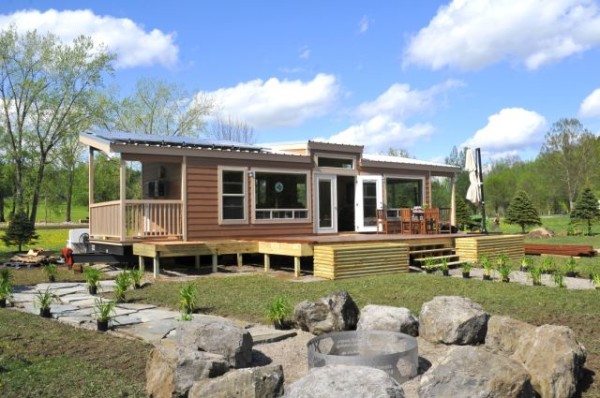
The unit has also been equipped with a complete assortment of eco-friendly cleaning and bathroom products, including coreless toilet paper that leaves no cardboard core at the end of the roll. Even the unit’s Amish-style furniture has been manufactured from recycled milk jugs and recycled hickory wood.
“We are very proud of this unit,” said Tim Gage, Cavco’s vice president, after trucking the 400-square foot cottage 2,600 miles to the Herkimer Diamond KOA campground in upstate New York. “It demonstrates not only the extent to which campgrounds are pursuing green initiatives, but it shows what Cavco is capable of producing as a company.”
Tim tells me that they are getting so many emails and requests for smaller homes and of course solar. With all the Green elements and 2KW of Off Grid Solar it will be available for $68,000 to the public. Freight, Generator and set-up is additional. One other item that I wanted to mention was that GENERAC is using a prototype propane generator for off grid living on the lodge. Very quiet when running.
For more information on Cavco’s eco-friendly park models, please contact Tim Gage at (602) 763-5488. www.cavcoparkhomes.com

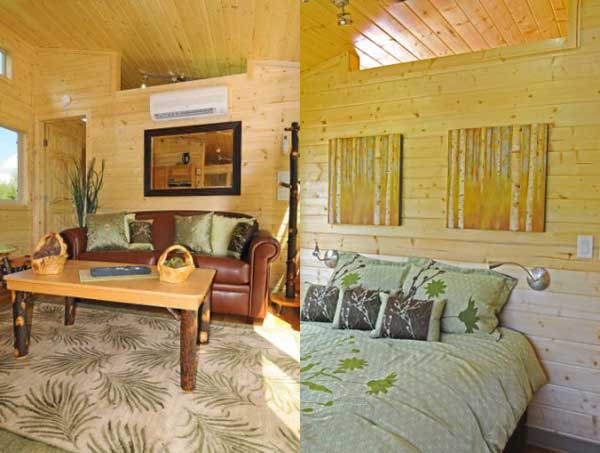
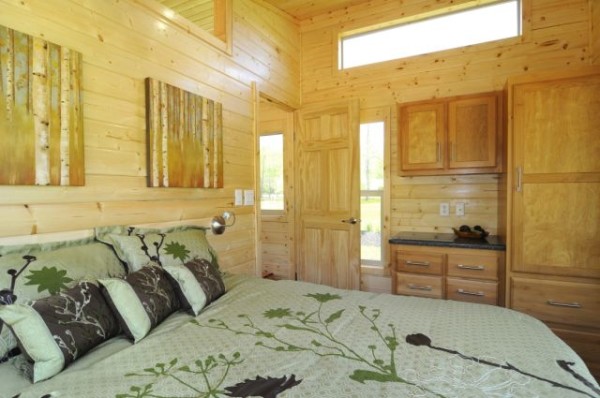
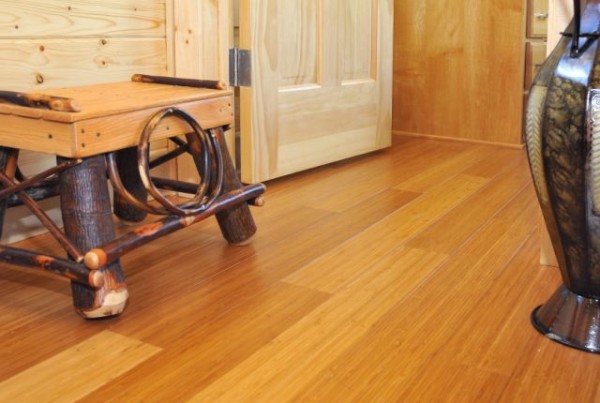

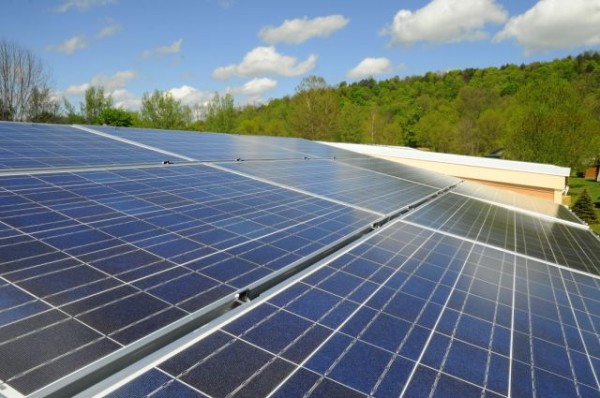
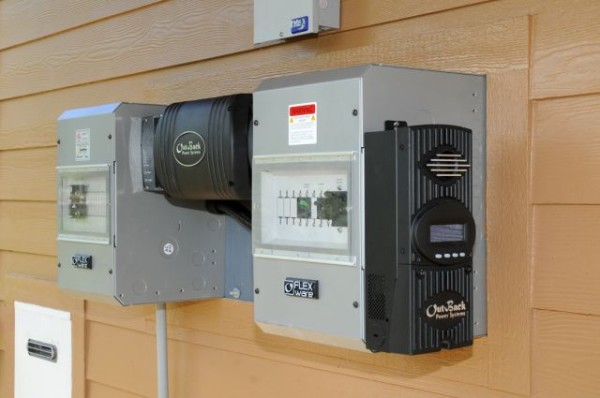
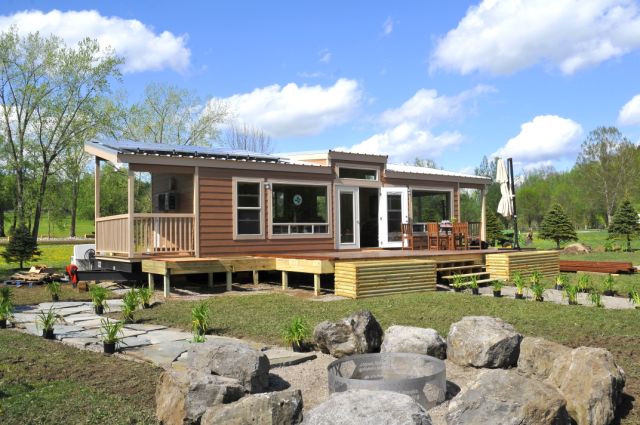

This looks awesome. Here’s a question for any solar experts out there — a 2 KW solar system, what does that mean for practical purposes i.e. in layman’s terms? For example, could you run a full complement of appliances? Or just a couple light bulbs? Or…? Anybody have any websites that can help explain this? Thanks, Nick
Interesting concept, I’m reminded of the Ideabox house. I’m having a little trouble matching the images to the plans. It looks like the Freedom 5 model, but I can’t figure out where the bunk beds next to the bathroom are located. NBD. Its a very nicely laid out plan for 400 s.f
I’m trying to see if I can get a floor plan from Cavco, if I do I will post it ASAP.
Hello, Nick S:
A 2 kW/h solar power system provides “minimalist” power. This is 2000 watts. It provides basic power and essential power, but is insufficient for heavy-duty power output. Here are some examples of power requirements for everyday household items, taken from the Michael Blue Jay web site:
Coffee maker: 900 watts
50-56″ LCD television: 260 watts
Desktop Computer & 17″ CRT monitor: 150 to 340 watts
100 watt light bulb: 100 watts (duh!)
CFL light bulb (60-watt equivalent): 18 watts
Electric oven, 350°F: 2000 watts
Clothes dryer (electric): 4400 watts
Clothes dryer (electric): 57 to 160 watts
48″ ceiling fan (high speed): 75 watts
Window unit AC, medium: 900 watts
Electric space heater (medium): 900 watts
Elec. furnace, 1000 sf, warm climate: 7941 watts
Elec. furnace, 2000 sf, cold climate: 26,500 watts
Here is a link:
http://michaelbluejay.com/electricity/howmuch.html
FYI for those interested in 5/11/10 power energy post above, Seven points:
#1 Beware of misinterpreting most of the consumption values from the michaelbluejay.com. As “Mr. Electricity” himself says “Probably better than half of the people who quote figures from this site in newspaper articles and blogs make some kind of mistake.” Be sure to study both:
1) http://michaelbluejay.com/electricity/misquote.html page (especially “Some devices use less than their rated wattage” section.
2) “Some important caveats” on the http://michaelbluejay.com/electricity/howmuch.html page.
Both to learn about the the average power use ratings, and about electric devices do not run continuously.
#2 Comparing Lester’s info from 2010, and Mr. Electricity’s calculator today, I see important differences. I recommend you use the calculator… properly.
#3 Clearly understand the difference between:
— power (watts, kilowatts) the rate at which energy is generated & consumed or rate at which work can be done.
— energy (watt-hour, Kw-hr) an amount that relates to how much work can be done (ideally, independent of how long it takes to do it).
— Lester makes a mistake in referring to a 2Kw/h solar system, but corrects himself when he says that is 2000 watts. The bigger and better a solar system, the more power it generates at any given instant. The longer it is generating power, the more energy it has produced over that duration.
#4 Keep in mind a solar system will produce less than rated power when sun/cloud conditions are less that what the system was rated for. (And may produce a little more than rated if the sun is brighter that the rating condition.)
#5 A solar system can power devices that draw more than it’s rated generating power, if the system has batteries, controller, and wiring necessary to save up solar energy and supply it to an appliance faster than the system generates it (or in the evening when it isn’t generating at all).
#6 For example, consider a 4000 watt rated electric water heater. It doesn’t run all the time, just when it’s supplied enough hot water or lost enough heat thru its insulation that the water at the tank’s thermostat says “turn on.” If it was on for a half hour. would use 2000-watt-hours of electricity, or what a 2000-watt solar system would produce in one hour of full-direct sun. But the panels couldn’t keep up with the electric demand, so a sufficiently charged battery (and controller) is needed. So when sizing an off-the-grid system for a home, careful planning of how energy is generated and stored and consumed thru out the day is needed to be sure the supply is there when you need to use it.
#7 Now it is time to revisit Point #1. Lester (mis)quotes Mr Electricity’s calculator when he writes:
Clothes dryer (electric): 4400 watts
Clothes dryer (electric): 57 to 160 watts
Mr Electric now writes: “The clothes washer/dryer results were so frequently misunderstood that I removed them from the general-purpose calculator, and now the calculator gives the results an a per-load basis, which is more meaningful.”
The 2000 watt array is essentially of little value unless it’s charging a battery bank. If it’s charging a battery bank (doesn’t say), then 2000 watts is actually plenty of power. I have been living off of an array that puts about 1600 watts into 24 six volt batteries, and it powers a normal household, though it’s just wife and I. We have all modern & ordinary conveinances. We also have an authomatic standby propane generator and it will start up and run for about 1 hour if we draw the batteries down too far. Examples of drawing down too far would be watching TV late. Wife running blow dryer/flat iron. Running AC into the evening hours. No problem, generator comes on. Cannot run conventional AC. We have Mitsubishi “mini-split,” (google it) system. It’s also a heat pump and it’s awesome. Very low draw compared to conventional HVAC. Having lived off grid now for close to 2 years, I’d say this sounds like a well appointed set up. My only reservation would be how much is it, compared to if I bought a base, stripped model and had everything installed. But most people probably don’t have the connections to do that. And, solar is very expensive with a lot of “Johnny-come-lately” installers out there who over-price and don’t know what they are doing. This Cavco model would aleviate those concerns because of their name standing behind it.
Lester,
Thank you for that cool information- I think I will use it to modify and lessen my energy consumption in my current house while I wait to sell and find my little dream home…
:->
It never fails to amaze me just how spaceous and beautiful 400 sq ft can be!
The high ceilings, large windows, and careful floor plan all working together to make tiny living so loveable 🙂
Thanks for keeping us informed…
“Very quick when running.”
I do hope you meant “quiet” — I hate chasing generators all over a campground!
I just checked with Tim and he said it should be “quiet.” I’ve edited the post and he plans on getting me more information on the generator.
KOA has made a corporate commitment to the small house concept, we call them “KOA Lodges”. This project was very time consuming but the R&D learnings that it has supplied have been invaluable. We have designed nine different floor plans that are used for guest lodging units. All of these plans are available from Cavco and this plan is based om the KOA 10 floor plan. The KOA plans have all been designed and refined by KOA’s engineering staff and are available to the retail buyer but are proprietary to KOA for commercial use. The Generator is a Generac and will be available to the public late this summer or early fall and is very quiet, <65 db. As far as power consumption, this house pulled less than 20 amps, full on!
Great photos. Using solar panels is a great way to run power to lodge! Thanks for sharing.
Awesome for a prefab park model! A nice break from the generic looking park models.
Absolutely sublime.
One of my ultimate goals as of late is to have an off grid abode to call my own. A small, humble and cozy little lodge like that, with plenty of space to grow food.
I love this. It helps me visualize that goal even more!
Here is an article that you may be interested in! It’s what is green about pressure treated wood!http://bit.ly/9TVMH9
Add water collection and storage, and a composting toilet and its almost perfect!
I am assuming there is no laundry in it, but fridge and heat could be propaine.
Decking and porches seem like such a waste of our precious resources – sitting on the lawn is great!
how much does a place like this cost?
I think it’s this one: http://www.cavco.com/cabins/arizona/default.asp?series=147&floorplan=CC-3412KLT